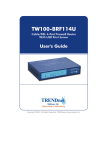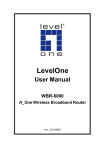Download Cisco WKPC54G Installation guide
Transcript
2 ® A Division of Cisco Systems, Inc. • Run the Setup Wizard CD-ROM - It is strongly recommended that you use the Setup Wizard CD-ROM to install the Router. Insert the Setup Wizard CD-ROM into the CD-ROM drive, and follow the on-screen instructions. • Use this Quick Installation guide - If you wish, you can use the Router’s web-based utility to install the Router. Proceed to Step 1, and follow the Quick Installation’s instructions. D E Instructions for installing the Wireless-G Notebook Adapter are in Step 3. 1 A Package Contents • Wireless-G Broadband Router • Wireless-G Notebook Adapter • Two Setup CD-ROMs (one with Symantec Internet Security) • Two User Guides on CD-ROM • Power Adapter • Ethernet Network Cable • Quick Installation Guide • Registration Card 2.4 GHz Wireless-G 802.11g Wireless Model No. Broadband Router and Notebook Adapter Quick Installation WKPC54G Configure the Broadband Router There are two ways to configure the Router. Choose one of the following: B C Connect the Broadband Router F G Before you begin, make sure that you have the setup information for your specific type of Internet connection. The installation technician from your ISP should have left this information with you after installing your broadband connection. If not, you can call your ISP to request the settings. H I Make sure that all of your network’s hardware is powered off, including the Router, PCs, and cable or DSL modem. Connect one end of an Ethernet network cable to one of the ports (labeled 1-4) on the back of the Router (Figure C), and the other end to an Ethernet port on a PC. J Connect a different Ethernet network cable from your cable or DSL modem to the Internet port on the Router’s back panel. This is the only port that will work for your modem connection. (Figure E) adapter is set to obtain an IP address automatically. For more information, refer to Windows Help. E The Power LED will flash green for a few seconds when the Router goes through its selfdiagnostic test. This LED will stay solidly lit when the self-test is complete. If it does not stop flashing, refer to “Appendix A: Troubleshooting” of the User Guide on the Setup CD-ROM. Power on the PC you wish to use to configure the Router. A B Connect the AC power adapter to the Router’s Power port and the other end into an electrical outlet. (Figure G) Proceed to Step 2. C NOTE: Make sure your PC’s Ethernet Power on the cable or DSL modem. Make sure the Power and Internet LEDs on the front panel light up green. D These instructions will show you how to configure the Router. You only need to configure it once. Repeat step C to connect additional PCs or other network devices to the Router. G IMPORTANT: Make sure you use the power adapter that is supplied with the Router. Use of a different power adapter could damage the Router. C Open your web browser. Enter http://192.168.1.1 in its Address field. Press the Enter key. (Figure A) A password request screen will appear. Leave the User Name field empty, and enter the default password, admin, in lowercase letters in the Password field. (For added security, you should later set a new password, using the Administration tab’s Management screen of the Web-based Utility). Then click the OK button. For the Internet Connection Type setting, five connection types are offered through the drop-down menu. Each Setup screen and available features will differ depending on which connection type you select. PPTP connection, check with your ISP for setup information. (D5) HeartBeat Signal: HeartBeat Signal is a service used in Australia only. If you are using a HeartBeat Signal connection, check with your ISP for setup information. (D6) E Internet Configuration Type A B DHCP: If you are connecting through DHCP or a dynamic IP address from your ISP, keep the default setting Obtain an IP automatically. (D1) Static IP: If your ISP assigns you a static IP address, select Static IP from the drop-down menu. Complete the Internet IP Address, Subnet Mask, Gateway, and Static DNS fields. You need to enter at least one DNS address. (D2) PPPoE: If you are connecting through PPPoE, select PPPoE from the drop-down menu. Complete the User Name and Password fields. (D3) The Web-based Utility will appear with the Setup tab selected. If requested by your ISP (usually cable ISPs), complete the Host Name and Domain Name fields. Otherwise, leave them blank. (Figure C) D1 G D2 D3 RAS: (for SingTel Users) RAS is a service used in Singapore only. If you are using a RAS connection check with your ISP for the necessary setup information. (D4) C PPTP: PPTP is a service used in Europe only. If you are using a F D4 H When you have finished entering your Internet connection settings, click the Save Settings button to save your changes. D5 D6 To configure the Router for your wireless network, select the Wireless Tab’s Basic Wireless Settings screen. (Figure F) Wireless Network Mode. Select the mode you are using from the drop-down menu: If you are using only 802.11 g, select G-Only; if you’re using 802.11b only, select B-Only; if you’re using both 802.11b and 802.11g, keep the default Mixed. Wireless Network Name (SSID). The SSID is the network name shared among all devices in a wireless network. The SSID must be identical for all devices in the wireless network. It is casesensitive and must not exceed 32 characters (use any keyboard character). For added security, you should F 3 change the default SSID linksys to a unique name. I K L A Wireless SSID Broadcast. When wireless clients survey the local area for wireless networks to associate with, they will detect the SSID broadcast by the Router. To broadcast the Router's SSID, keep the default setting, Enable. If you do not want to broadcast the Router's SSID, then select Disable. B C D Change these settings as described here and click the Save Settings button to apply your changes. Power your modem off and back on again. M N Restart your computer. Test the setup by opening your web browser and entering http://www.linksys.com/ registration. (Figure N) The installation of the Wireless-G Broadband Router is complete. E If you are running Windows 98SE, Windows Me, or Windows 2000 Wireless Channel. Select the appropriate channel from the list provided to correspond with your network settings. All devices in your wireless network must broadcast on the same channel in order to function correctly. J Install the Notebook Adapter N NOTE: For more advanced settings and security options, refer to the User Guide on the Setup CD-ROM. Insert the Wireless-G Network Adapter Setup Wizard CD-ROM into your CD-ROM drive. The Setup Wizard should run automatically, and the Welcome screen should appear. If it does not, click Start and choose Run. In the field that appears, enter D:\setup.exe (if “D” is the letter of your CD-ROM drive). Click the Install button. After reading the License Agreement, click Next. The next screen has you choose a wireless mode. Click Infrastructure Mode if you want your wireless computers to communicate using a wireless access point. Click AdHoc Mode if you want multiple wireless computers to network directly with each other without using a wireless access point. In the SSID field, enter the SSID of your wireless network. The SSID must be identical for all devices in the network. The default setting is linksys (all lowercase). Click Next. B F G D NOTE: For security, Linksys recommends that you change the default SSID to a unique name. H I If you chose Infrastructure Mode, go to Step F now. If you chose Ad-Hoc Mode, select a Channel from the list provided. All computers on your wireless network must use the same channel in order to communicate with each other. If you are unsure about which channel to use, select the default channel (Channel 6). Also, select the mode you are using from the drop-down menu: If you are using only 802.11g, select G-Only; if you’re using 802.11b only, select B-Only; if you’re using both 802.11b and 802.11g, keep the default Mixed. The Setup Wizard will ask you to review your settings before it starts to copy files. Click Next to keep your settings, or click Back to change any settings. After the files have been successfully copied, you will see the Congratulations screen. Click the Exit button. J E B C F D E I Locate an available PCMCIA slot on your notebook PC. B instructions and screenshots for Windows XP with Service Pack 1 installed. If you have not installed Service Pack 1, select the network you want, and click the Connect button. If the network has WEP encryption enabled, enter the WEP key in the Network key field, and then click the Connect button. F Insert the Adapter with the label side facing up, so the Adapter fits snugly in the PCMCIA slot. Windows XP will automatically detect the Adapter. Insert the Adapter Setup CD-ROM into your CD-ROM drive. Select Install the software automatically (Recommended). Then click Next. When Windows has finished installing the driver, click Finish. H NOTE: Note: Steps F and G are the The installation of the Adapter is complete. A Confirm network key field. Then click Connect. Right-click the icon and select View Available Wireless Networks. If you are running Windows XP Locate an available PCMCIA slot on your notebook PC. Insert the Adapter with the label side facing up, so the Adapter fits snugly in the PCMCIA slot. Windows will begin copying the driver files to your computer. If Windows asks you for the original Windows CD-ROM, insert the CD-ROM, and direct Windows to its proper location (e.g., D:\). I The installation of the Adapter is complete. If this network has WEP encryption enabled, go to Step G. C NOTE: Windows XP has a built-in configuration tool. Use Windows XP Wireless Zero Configuration (in the system tray at the bottom of your screen) to configure the Adapter. After installing the Adapter, the Windows XP Wireless Zero Configuration icon will appear in your computer’s system tray. G E If WEP is enabled, the screen in Figure G will appear. Enter the WEP key of your wireless network in the Network key field, and re-enter it in the For more information about WEP, refer to the Router’s documentation on the Router’s Setup CD-ROM, or visit www.linksys.com. H For more information about wireless networking on a Windows XP computer, enter the keyword wireless in the Windows XP search engine. The screen that appears will show any available wireless network. Select the network you want. If this network does not have WEP encryption enabled, then the screen in Figure F will appear. Make sure that Allow me to connect to the selected wireless network, even though it is not secure is checked. Then click Connect, and go to Step H. The screen in Figure H will appear if your connection is active. F For additional information or troubleshooting help, refer to the User Guide on the Setup CDROM. You can also call or e-mail for further support. 24-hour Technical Support 800-326-7114 (toll-free from US or Canada) E-mail Support [email protected] Website http://www.linksys.com or http://support.linksys.com RMA (Return Merchandise Authorization) http://www.linksys.com/support FTP Site ftp://ftp.linksys.com Sales Information 800-546-5797 (800-LINKSYS) Linksys is a registered trademark or trademark of Cisco Systems, Inc. and/or its affiliates in the U.S. and certain other countries. Copyright © 2004 Cisco Systems, Inc. All rights reserved. G WKPC54G-QI-40225NC JL











